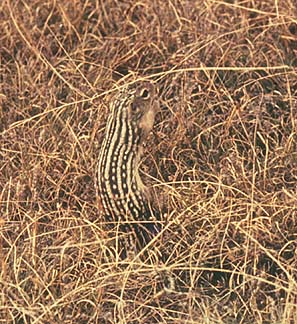- Thirteen-lined ground squirrel
Taxobox
name = Thirteen-lined ground squirrel
status = LR/lc | status_system = IUCN2.3

regnum =Animal ia
phylum =Chordata
classis =Mammal ia
ordo =Rodent ia
familia =Sciuridae
genus = "Spermophilus "
species = "S. tridecemlineatus"
binomial = "Spermophilus tridecemlineatus"
binomial_authority = (Mitchill, 1821)The thirteen-lined ground squirrel ("Spermophilus tridecemlineatus"), also known as the striped gopher, a squinney in parts ofIowa , and as the leopard-spermophile in Audubon’s day, is a brownish ground squirrel with 13 alternating brown and whitish longitudinal lines (sometimes partially broken into spots) on back and sides creating rows of whitish spots within dark lines.The thirteen-lined ground squirrel is the namesake of the
University of Minnesota Golden Gophers teams, and responsible forMinnesota 's nickname as theGopher State .The thirteen-lined ground squirrel is strictly diurnal and is especially active on warm days. A solitary or only somewhat colonial hibernator, it often occurs in aggregations in suitable habitats.
In late summer, it puts on a heavy layer of fat and stores some food in its burrow. It enters its nest in October (some adults retire much earlier), rolls into a stiff ball, and decreases its respiration from between 100 and 200 breaths per minute to one breath about every five minutes. It emerges in March or early April.
The burrow may be 15 to 20 feet (4.5–6 m) long, with several side passages. Most of the burrow is within 1 to 2 feet (about half a meter) of the surface, with only the hibernation nest in a special deeper section. Shorter burrows are dug as hiding places. Home range is 2 to 3 acres (0.8 to 1.2 ha).
Primary diet includes grass and weed seeds,
caterpillar s, andgrasshopper s, but may also eat bird flesh and even mice and shrews. This squirrel sometimes damages gardens by digging burrows and eating vegetables, but also devours weed seeds and harmful insects.Well known for standing upright to survey its domain, diving down into its burrow when it senses danger, then sometimes poking out its nose and giving a bird-like trill. It has a maximum running speed of 8 mph (13 km/h), and reverses direction if chased. Great numbers of these squirrels are killed by automobiles.
External links
* [http://www.ncbi.nlm.nih.gov/entrez/query.fcgi?db=genomeprj&cmd=Retrieve&dopt=Overview&list_uids=13936 Thirteen-lined Ground Squirrel Genome Project page at GenBank]
*ITIS|ID=180162|taxon=Spermophilus tridecemlineatus|year=2006|date=8 October
Wikimedia Foundation. 2010.
